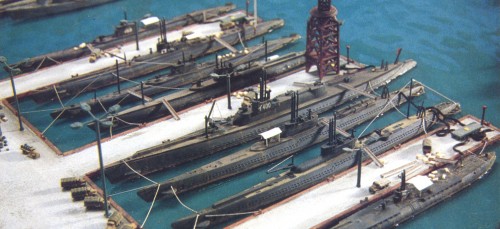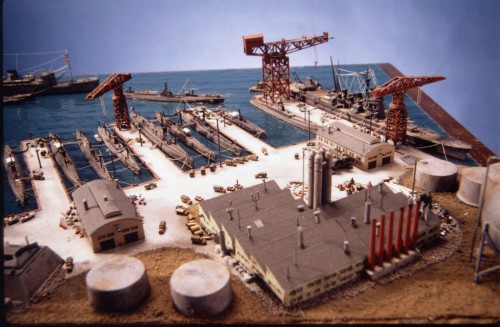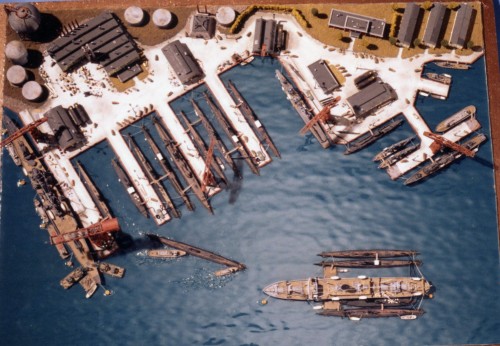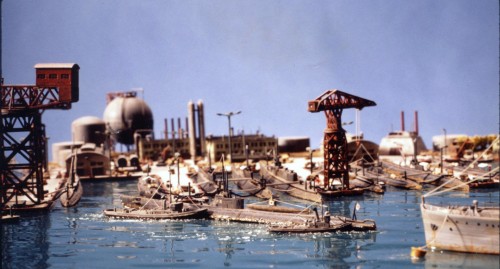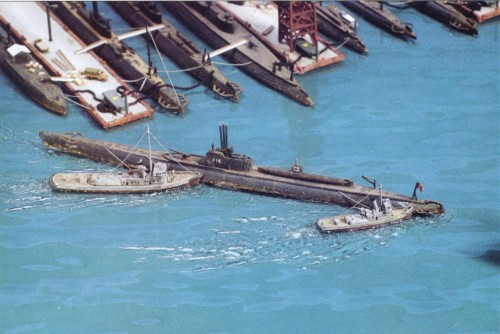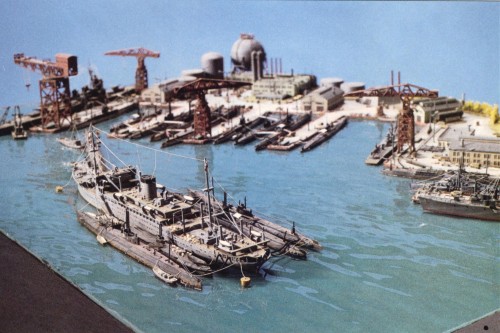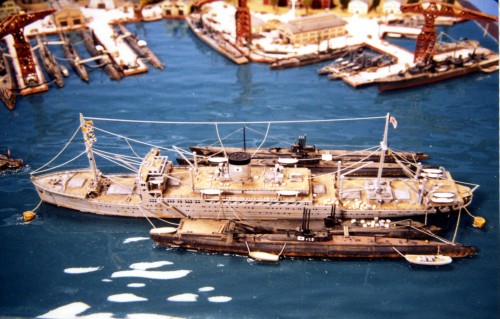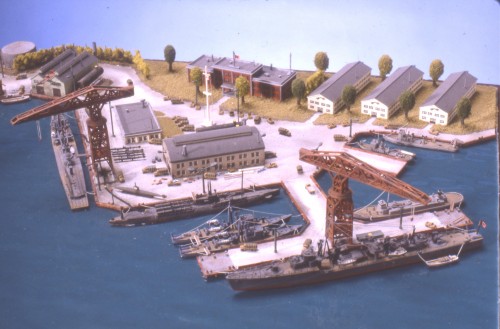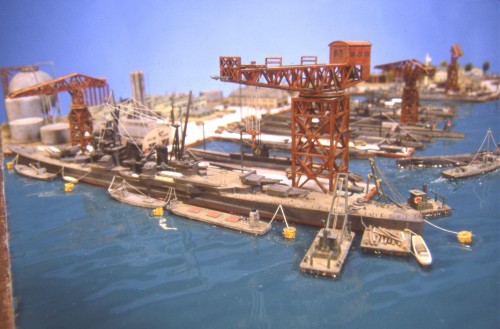This artist is a master of Naval dioramas! Ken Hart places so much detail in his works! INCREDIBLE!!! I love them!
This is what artist Ken Hart has to say…
Back in the mid-1980s, all these tiny little 1/700 scale kits and accessories began to come to American hobby shops, and I was intrigued with a lot of what I saw.
Many of the small submarine kits came only as waterline models, while some featured the option of lower hulls as well. Along with ships and submarines, the catalog of 1/700 scale accessories kits was vast – harbor sets, with tug boats and various utility ships; pier sets, with mooring buoys, wharf-side cranes, and pier-side effects… There were even sets with buildings – barracks, administrations buildings, machine shops and manufacturing shops. And there were sets containing miniature submarines made to ride piggyback on mother subs, as well as tiny submarines built as one-man guided torpedoes.
When these fancy little kits piqued my curiosity, I found myself delving into researching what I didn’t know about the Imperial Japanese Navy’s submarine force. Back then, before the internet and this new age of information, research meant trips to libraries and bookstores, and exchanging information through letters between fellow historians and modellers.
These tiny, miniscule little models were fairly well detailed, and nicely cast, offering a wide selection that would allow quite a range of possibilities. To me, it spelled diorama. And so I decided to give it a go.
A sheet of 1/8″ water-glass from a local stained glass shop was painted on the flat underside, and mounted on a 22″ x 30″ base, for which I’d made an 12″ tall plexiglass dustcover to protect the diorama during and after construction.
Rather than try to form the mountainous hillsides prevalent along much of Japan’s seacoast, I went with a simple flat layout to represent enough of a base to house the variety of these little 1/700 scale waterline ships and submarines. I picked up what kits and accessories kits I could find, and added further effects from hunting through model railroad shops and from scratch building various necessities.
The scene was totally fictitious, and represented details I’d seen from looking at dozens of photos of WWII Japanese naval base installations – a sort of mesh-mash to include everything and anything. The whole project was just for the fun of using all these cool little 1/700 scale models.
When the diorama was on display at a model show one day, I noticed an elderly man staring at it contemplatively. For a good half hour or so. I went and talked with him.
“I’ve flown over a lot of Japanese bases during the war,” he told me. “And now, looking at this model, I almost feel like I’m back in a Mitchell B-17 again, flying over one of them.”
What a compliment that was to hear. Appreciation of one’s work and efforts is the most uplifting reward any modeller or artist can receive. But what the man said next really cast me for a loop.
“The only trouble,” he told me, “is that the water in this model is blue/green. All the ports and naval bases around Japane were usually a sort of brownish-green, from all the mudslides of the hilly terrain.”
That was a detail I hadn’t known. All the photos I looked at for reference were B&W shots, except for a few color pictures of Pearl Harbor. So I had erroneously extrapolated the wrong color for the water for my diorama. Too late to change it, I had to accept it. Hindsight is always clearer.
When I look back at any of my old work, I always see all kinds of room for improvement. I’ll spot little details that bother me, details I’d missed while the fatiguing vision of my endeavors were focused on other aspects of the work. We always want to get each little thing right, naturally. Those are the things we see the most when we look back at our efforts. Given the opportunity to change whatever details we might not like, many of our best work would never be finished.
This imperfect diorama with all its little errors and flaws, was featured first in Scale Ship Modeler Aug./Sept. 1990 (Vol.13, No.6), then later on in Scale Ship Modeler Aug./Sept. 1990 (Vol.13, No.6), and in MODEL ART of Japan (No.371) June 199, as well as a few other magazines.
Nine photos – without any specific captions.
Fair seas and following winds !
— Ken Hart —


